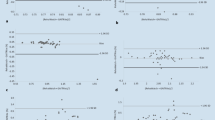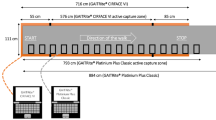Abstract
During walking on an instrumented treadmill with an embedded force platform or grid of pressure sensors, center-of-pressure (COP) trajectories exhibit a characteristic butterfly-like shape, reflecting the medio-lateral and anterior–posterior weight shifts associated with alternating steps. We define “gaitography” as the analysis of such COP trajectories during walking (the “gaitograms”). It is currently unknown, however, if gaitography can be employed to characterize pathological gait, such as lateralized gait impairments. We therefore registered gaitograms for a heterogeneous sample of persons with a trans-femoral and trans-tibial amputation during treadmill walking at a self-selected comfortable speed. We found that gaitograms directly visualize between-person differences in prosthetic gait in terms of step width and the relative duration of prosthetic and non-prosthetic single-support stance phases. We further demonstrated that one should not only focus on the gaitogram’s shape but also on the time evolution along that shape, given that the COP evolves much slower in the single-support phase than in the double-support phase. Finally, commonly used temporal and spatial prosthetic gait characteristics were derived, revealing both individual and systematic differences in prosthetic and non-prosthetic step lengths, step times, swing times, and double-support durations. Because gaitograms can be rapidly collected in an unobtrusive and markerless manner over multiple gait cycles without constraining foot placement, clinical application of gaitography seems both expedient and appealing. Studies examining the repeatability of gaitograms and evaluating gaitography-based gait characteristics against a gold standard with known validity and reliability are required before gaitography can be clinically applied.



Similar content being viewed by others
References
Andriacchi TP, Ogle JA, Galante JO (1977) Walking speed as a basis for normal and abnormal gait measurements. J Biomech 10:261–268
Barnett C, Vanicek N, Polman R, Hancock A, Brown B, Smith L, Chetter I (2009) Kinematic gait adaptations in unilateral transtibial amputees during rehabilitation. Prosthet Orthot Int 33:135–147
Davis BL, Cavanagh PR (1993) Decomposition of superimposed ground reaction forces into left and right force profiles. J Biomech 26:593–597
Dingwell JB, Davis BL, Frazier DM (1996) Use of an instrumented treadmill for real-time gait symmetry evaluation and feedback in normal and trans-tibial amputee subjects. Prosthet Orthot Int 20:101–110
Dingwell JB, Davis BL (1996) A rehabilitation treadmill with software for providing real-time gait analysis and visual feedback. J Biomech Eng 118:253–255
Fridman A, Olna I, Isakov E (2003) The influence of prosthetic foot alignment on transtibial amputee gait. Prosthet Orthot Int 27:17–22
Geijtenbeek T, Steenbrink F, Otten B, Even-Zohar O (2011) D-Flow: immersive virtual reality and real-time feedback for rehabilitation. In: Proceedings of VRCAI 2011: ACM SIGGRAPH conference on virtual-reality continuum and its applications to industry, pp 201–208
Hansen AH, Meier MR, Sessoms PH, Childress DS (2006) The effects of prosthetic foot roll-over shape arc length on the gait of trans-tibial prosthesis users. Prosthet Orthot Int 30:286–299
Houdijk H, van Ooijen MW, Kraal JJ, Wiggerts HO, Polomski W, Janssen TW, Beek PJ (2012) Assessing gait adaptability in people with a unilateral amputation on a treadmill with visual context. Phys Ther 92:1452–1460
Isakov E, Burger H, Krajnik J, Gregoric M, Marincek C (1996) Influence of speed on gait parameters and on symmetry in trans-tibial amputees. Prosthet Orthot Int 20:153–158
Isakov E, Burger H, Krajnik J, Gregoric M, Marincek C (1997) Double-limb support and step-length asymmetry in below-knee amputees. Scand J Rehabil Med 29:75–79
Isakov E, Keren O, Benjuya N (2000) Trans-tibial amputee gait: time–distance parameters and EMG activity. Prosthet Orthot Int 24:216–220
Jaegers SM, Arendzen JH, de Jongh HJ (1995) Prosthetic gait of unilateral transfemoral amputees: a kinematic study. Arch Phys Med Rehabil 76:736–743
Mattes SJ, Martin PE, Royer TD (2000) Walking symmetry and energy cost in persons with unilateral transtibial amputations: matching prosthetic and intact limb inertial properties. Arch Phys Med Rehabil 81:561–568
Mawase F, Haizler T, Bar-Haim S, Karniel A (2013) Kinetic adaptation during locomotion on a split-belt treadmill. J Neurophysiol 109:2216–2227
Nolan L, Wit A, Dudziñski K, Lees A, Lake M, Wychowañski M (2003) Adjustments in gait symmetry with walking speed in trans-femoral and trans-tibial amputees. Gait Posture 17:142–151
Prieto TE, Myklebust JB, Hoffmann RG, Lovett EG, Myklebust BM (1996) Measures of postural steadiness: differences between healthy young and elderly adults. IEEE Biomed Eng 43:956–966
Rabuffetti M, Recalcati M, Ferrarin M (2005) Trans-femoral amputee gait: socket-pelvis constraints and compensation strategies. Prosthet Orthot Int 29:183–192
Robinson JL, Smidt GL, Arora JS (1977) Accelerographic, temporal, and distance gait factors in below-knee amputees. Phys Ther 57:898–904
Roerdink M, De Haart M, Daffertshofer A, Donker SF, Geurts AC, Beek PJ (2006) Dynamical structure of center-of-pressure trajectories in patients recovering from stroke. Exp Brain Res 174:256–269
Roerdink M, Lamoth CJC, Kwakkel G, Van Wieringen PCW, Beek PJ (2007) Gait coordination after stroke: benefits of acoustically paced treadmill walking. Phys Ther 87:1009–1022
Roerdink M, Coolen H, Clairbois HE, Lamoth CJC, Beek PJ (2008) Online gait event detection using a large force platform embedded in a treadmill. J Biomech 41:2628–2632
Roerdink M, Beek PJ (2011) Understanding inconsistent step-length asymmetries across hemiplegic stroke patients: impairments and compensatory gait. Neurorehabil Neural Repair 25:253–258
Roerdink M, Roeles S, van der Pas SC, Bosboom O, Beek PJ (2012) Evaluating asymmetry in prosthetic gait with step-length asymmetry alone is flawed. Gait Posture 35:446–451
Rueterbories J, Spaich EG, Larsen B, Andersen OK (2010) Methods for gait event detection and analysis in ambulatory systems. Med Eng Phys 32:545–552
Sagawa Y Jr, Turcot K, Armand S, Thevenon A, Vuillerme N, Watelain E (2011) Biomechanics and physiological parameters during gait in lower-limb amputees: a systematic review. Gait Posture 33:511–526
Stins JF, Michielsen ME, Roerdink M, Beek PJ (2009) Sway regularity reflects attentional involvement in postural control: effects of expertise, vision and cognition. Gait Posture 30:106–109
Tura A, Raggi M, Rocchi L, Cutti AG, Chiari L (2010) Gait symmetry and regularity in transfemoral amputees assessed by trunk accelerations. J Neuroeng Rehabil 7:4
Van Ingen Schenau GJ (1980) Some fundamental aspects of the biomechanics of overground versus treadmill locomotion. Med Sci Sports Exerc 12:257–261
Verkerke GJ, Hof AL, Zijlstra W, Ament W, Rakhorst G (2005) Determining the centre of pressure during walking and running using an instrumented treadmill. J Biomech 38:1881–1885
Zmitrewicz RJ, Neptune RR, Walden JG, Rogers WE, Bosker GW (2006) The effect of foot and ankle prosthetic components on braking and propulsive impulses during transtibial amputee gait. Arch Phys Med Rehabil 87:1334–1339
Acknowledgments
The contribution of Melvyn Roerdink was supported by Veni Grant 451-09-024 of the Netherlands Organization for Scientific Research (NWO). The authors are grateful to Bert Coolen for implementing the software for online gait-event detection.
Author information
Authors and Affiliations
Corresponding author
Rights and permissions
About this article
Cite this article
Roerdink, M., Cutti, A.G., Summa, A. et al. Gaitography applied to prosthetic walking. Med Biol Eng Comput 52, 963–969 (2014). https://doi.org/10.1007/s11517-014-1195-1
Received:
Accepted:
Published:
Issue Date:
DOI: https://doi.org/10.1007/s11517-014-1195-1




